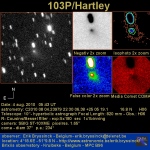Begin Planning Your Journey to Comet 103P/Hartley
Board your time machine to the stars near the end of October
September is the time for you and the kids to begin planning a journey to a celestial body that will be at its closest point to Earth and Sol, sometime near the end of October. Comet 103P/Hartley has been in the news, of late, as NASA's Deep Impact spacecraft will fly by Comet 103P/Hartley, in the first part of November. Observers boarding their time-machine-to-the-stars at this time should get a nice view of Comet 103P/Hartley and it might even be possible to view this celestial object with the naked eye, depending on the environmental conditions at the time of viewing. A good pair of viewing binoculars should give viewers a great view of Comet 103P/Hartley, but your time machine to the stars is the best way to journey to Comet 103P/Hartley, to have a look at a celestial object that only becomes viewable during specific periods of time. Comet 103P/Hartley is returning to Earth for the fourth time, since Australian astronomer Malcolm Hartley discovered her in 1986. A short-period comet that loops through the inner solar system, Comet 103P/Hartley's space journey takes about 6.5 years to complete one orbit. You should arrive at Comet 103P/Hartley just before the arrival of NASA's Deep Impact spacecraft.
During the visit by NASA's Deep Impact spacecraft, space scientists will use the information and data provided by on-board cameras and instruments to help them pierce the shroud surrounding the comet and hopefully determine the source of dusty jets viewed on Comet 103P/Hartley. Dusty jets that have been dancing in the dreams of space scientists, since they first viewed them through Earth-bound telescopes, which show the effect as a pinprick of light at the center of the comet's glow. Astronomers and space scientists refer to this effect as a comet's "false nucleus", which hides the comets real surface from view.
Comet 103P/Hartley is becoming more visible to star gazers as it approaches the Earth and Sun. This celestial object could reach magnitude 10 near the end of September, which will make viewing easier for star gazers, and allow space scientists to study this comet closer. The best time for star gazers to view Comet 103P/Hartley will be under a dark sky starting around September 24. Comet 103P/Hartley will be in the arms of Cassiopeia at this time, south of Cassiopeia's w-shaped asterism, and will be viewable throughout the night.
In : Comet 103P/Hartley
